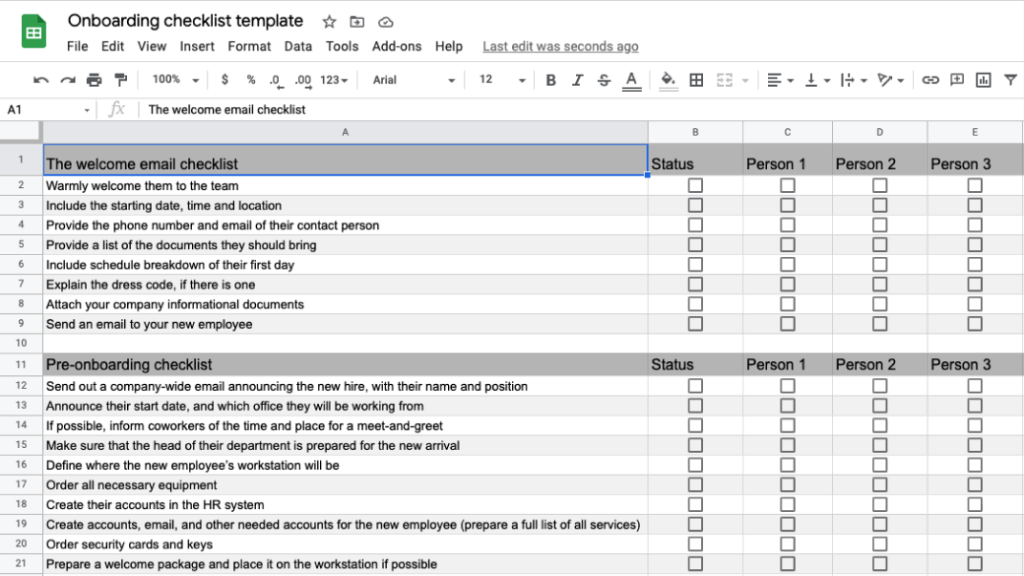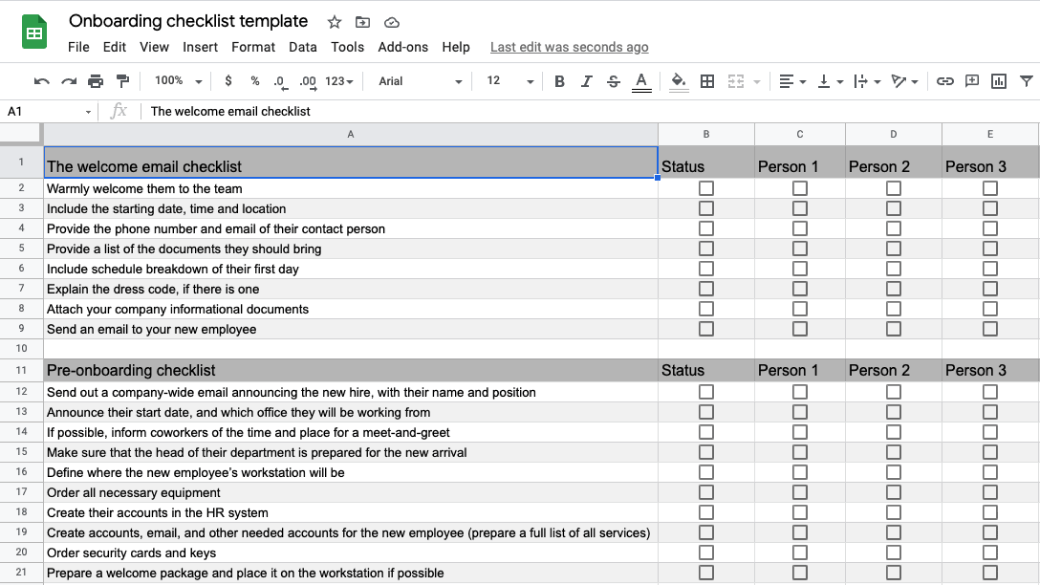
The Ultimate Checklist for Hiring New Employees: A Step-by-Step Guide
Hiring new employees is a critical process for any organization. A well-structured hiring process ensures that you attract, select, and onboard the best talent, contributing to your company’s success. This comprehensive checklist for hiring new employees will guide you through each stage, from defining the job requirements to successfully integrating the new hire into your team. Following this checklist for hiring new employees can save time and resources, and ensure a consistent and legally compliant hiring process.
Phase 1: Defining the Role and Requirements
Identify the Need
Before you begin the hiring process, clearly define why the new role is needed. Is it due to company growth, employee turnover, or the creation of a new department? Understanding the underlying reason will help you tailor the job description and target the right candidates. A clear understanding of the need sets the foundation for a successful checklist for hiring new employees.
Create a Detailed Job Description
A well-crafted job description is essential for attracting qualified candidates. Include the following elements:
- Job Title: Accurate and descriptive.
- Department: Specify the department the role belongs to.
- Reporting Structure: Who will the new employee report to?
- Responsibilities: List the primary duties and tasks. Be specific and avoid vague language.
- Required Skills and Qualifications: Outline the necessary technical skills, soft skills, education, and experience. Differentiate between essential and preferred qualifications.
- Company Culture and Values: Briefly describe your company culture and values to attract candidates who align with your organization.
- Salary Range: Be transparent about the salary range to avoid wasting time on candidates whose expectations don’t align with your budget.
Spending time on creating a detailed job description is a crucial step in the checklist for hiring new employees.
Determine Compensation and Benefits
Research industry standards and internal compensation structures to determine a competitive salary and benefits package. Consider factors such as experience, skills, and location. Benefits may include health insurance, retirement plans, paid time off, and other perks. A competitive compensation package is vital for attracting top talent and is a key consideration in our checklist for hiring new employees.
Phase 2: Sourcing and Screening Candidates
Choose the Right Recruitment Channels
Select the appropriate recruitment channels to reach your target audience. Consider using a combination of the following:
- Job Boards: LinkedIn, Indeed, Glassdoor, etc.
- Company Website: Post the job opening on your company’s career page.
- Social Media: Utilize platforms like LinkedIn, Twitter, and Facebook to promote the job.
- Employee Referrals: Encourage current employees to refer qualified candidates.
- Recruiting Agencies: Partner with a recruiting agency for specialized roles.
Strategic selection of recruitment channels is important in the checklist for hiring new employees.
Screen Resumes and Applications
Carefully review all resumes and applications to identify candidates who meet the minimum qualifications. Use a standardized screening process to ensure fairness and consistency. Look for:
- Relevant Experience: Does the candidate have the required experience for the role?
- Skills: Do they possess the necessary technical and soft skills?
- Education: Do they meet the educational requirements?
- Job Stability: How frequently have they changed jobs?
- Cover Letter: Did they submit a well-written cover letter that demonstrates their interest in the role?
Resume screening is a crucial part of the checklist for hiring new employees that helps filter out unqualified applicants.
Conduct Initial Phone Screens
Before inviting candidates for in-person interviews, conduct phone screens to assess their communication skills, cultural fit, and salary expectations. Prepare a list of standardized questions to ask each candidate. This step saves time and resources by filtering out unsuitable candidates early in the process. Phone screening is a critical step in the checklist for hiring new employees.
Phase 3: Interviewing and Assessment
Prepare for Interviews
Develop a structured interview process with pre-determined questions and evaluation criteria. Involve multiple interviewers to gain different perspectives. Prepare interview questions that assess:
- Technical Skills: Assess their knowledge and expertise in relevant areas.
- Problem-Solving Skills: Present scenarios to evaluate their problem-solving abilities.
- Behavioral Skills: Use behavioral questions to understand how they have handled past situations (e.g., “Tell me about a time when you had to overcome a challenging obstacle.”).
- Cultural Fit: Assess whether they align with your company’s values and culture.
Thorough interview preparation is a key component of the checklist for hiring new employees.
Conduct Interviews
Conduct in-person or video interviews with shortlisted candidates. Encourage candidates to ask questions to gauge their interest and engagement. Take detailed notes during the interviews to help with the evaluation process. The interview process is central to the checklist for hiring new employees.
Assess Skills and Abilities
Depending on the role, you may need to conduct skills assessments or tests to evaluate candidates’ technical abilities. This could include coding tests, writing samples, or presentations. Skills assessment provides objective data to support your hiring decision, and is an important part of the checklist for hiring new employees.
Check References
Contact the candidate’s previous employers to verify their work history and performance. Ask specific questions about their strengths, weaknesses, and overall suitability for the role. Checking references is a vital step in the checklist for hiring new employees to ensure the candidate’s claims are accurate.
Phase 4: Making the Offer and Onboarding
Extend the Job Offer
Once you’ve made your decision, extend a formal job offer to the selected candidate. The offer letter should include:
- Job Title
- Salary
- Benefits
- Start Date
- Reporting Structure
- Terms of Employment
Ensure the offer is clear, concise, and legally compliant. Presenting a clear job offer is a critical step in the checklist for hiring new employees.
Negotiate Terms
Be prepared to negotiate the terms of the offer with the candidate. This may involve salary, benefits, or other aspects of the employment agreement. A willingness to negotiate demonstrates flexibility and can help secure top talent. Negotiation skills are important in this phase of the checklist for hiring new employees.
Conduct Background Checks
Before finalizing the offer, conduct background checks to verify the candidate’s criminal history, employment history, and educational credentials. This is essential for protecting your company and employees. Background checks are a crucial safety measure within the checklist for hiring new employees.
Onboard the New Employee
A well-structured onboarding program is crucial for integrating new employees into your organization. Include the following elements:
- Welcome and Introduction: Introduce the new employee to their team and other key stakeholders.
- Training: Provide comprehensive training on their role, responsibilities, and company policies.
- Mentorship: Assign a mentor to provide guidance and support.
- Performance Goals: Set clear performance goals and expectations.
- Regular Check-ins: Schedule regular check-ins to provide feedback and address any concerns.
Effective onboarding is the final and essential step in the checklist for hiring new employees, ensuring a smooth transition and contributing to long-term success. Implementing a robust checklist for hiring new employees from start to finish increases the likelihood of finding and retaining top talent. This detailed checklist for hiring new employees will help streamline your hiring process and ensure you make the best possible hiring decisions. By following each step in this checklist for hiring new employees, you can minimize risks and maximize the chances of a successful hire. Remember to adapt this checklist for hiring new employees to suit your specific organizational needs and legal requirements. Proper execution of this checklist for hiring new employees translates to a more efficient and effective recruitment process. Continual review and improvement of your checklist for hiring new employees ensures it remains relevant and effective. Ultimately, this comprehensive checklist for hiring new employees will contribute to a stronger, more successful workforce. Use this detailed checklist for hiring new employees as a framework to build your own tailored hiring process. This checklist for hiring new employees is designed to be a flexible and adaptable resource for any organization. Finally, this checklist for hiring new employees serves as a reminder of the importance of a structured and thoughtful approach to recruitment.
[See also: How to Conduct Effective Employee Interviews]
[See also: The Importance of Onboarding New Employees]

